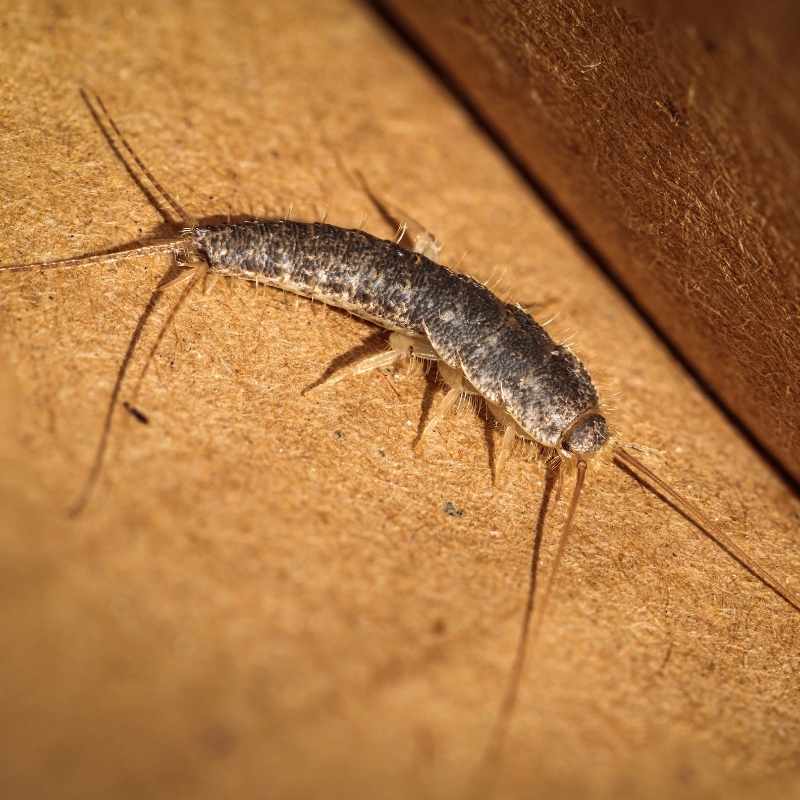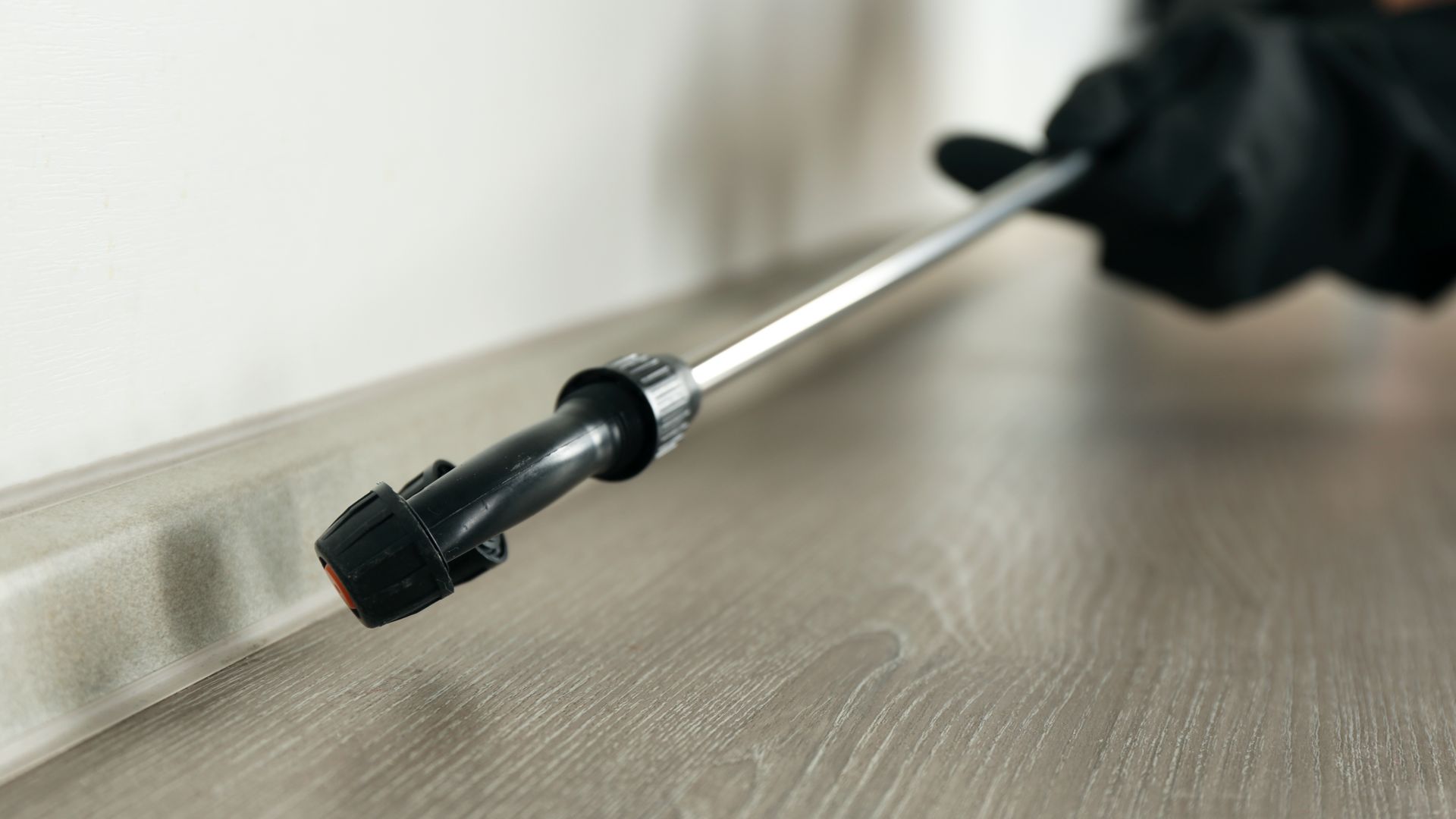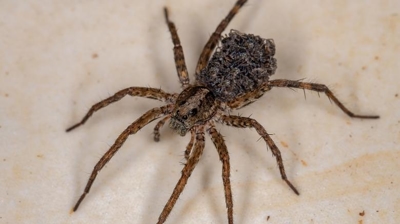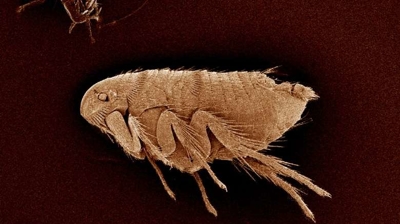
Silverfish

Are Silverfish Harmful?
Silverfish (Lepisma saccharina) are generally considered nuisance pests rather than directly harmful, but they can still cause various problems in homes and businesses. Here are some key ways in which silverfish can be considered harmful:
- Property Damage: Silverfish feed on starchy materials and proteins, which can lead to significant damage over time. Books, wallpaper, important documents, and stored paper materials can be eaten or stained by silverfish. Fabrics like cotton, silk, and linen, as well as synthetic blends, can be chewed on, leading to holes and deterioration. Wallpaper glue, book bindings, and cardboard storage boxes can be damaged as silverfish feed on adhesives.
- Food Contamination: Silverfish can invade pantries and consume dry foods such as flour, cereals, rice, oats, and sugar. While they don’t transmit diseases, their presence in food can make it unappetizing and lead to contamination through their droppings, shed scales, and exoskeletons.
- Allergens & Indoor Air Quality Issues: Silverfish shed their exoskeletons as they grow, leaving behind molted skins and waste. These remnants can contribute to dust buildup in the home and may trigger allergies or respiratory irritation in sensitive individuals, especially those with asthma.
- Indication of Moisture Problems: While silverfish themselves may not cause structural damage, their presence often indicates excessive humidity, leaks, or poor ventilation. If left unaddressed, this moisture can lead to mold growth and attract other pests such as termites or cockroaches.
- Psychological & Aesthetic Concerns: Silverfish are fast-moving and tend to appear unexpectedly, which can startle homeowners. Their presence in bookshelves, closets, or kitchen areas can create an impression of uncleanliness, making them particularly problematic for businesses such as hotels, libraries, and museums.
Learn more: Do Silverfish Bite? || What Do Silverfish Eat? || What Do Silverfish Look Like?
Silverfish Removal
Getting rid of silverfish is important for several reasons, primarily related to health, property damage, and overall hygiene. While silverfish are not directly dangerous to humans in terms of bites or disease transmission, they pose significant indirect risks and nuisances:
Property and Material Damage
Silverfish feed on starchy materials and proteins, which means they can damage a wide variety of household items:
- Paper products: They consume books, important documents, wallpaper, and cardboard. Rare or sentimental books can be permanently damaged.
- Textiles: Clothing, upholstery, and fabrics containing natural fibers (cotton, silk, linen) may be eaten or frayed.
- Food: In kitchens and pantries, they can infest dry goods like flour, cereals, pasta, and grains, contaminating food supplies.
- Glue and adhesives: Silverfish can even eat adhesives used in book bindings or wallpaper, weakening structural integrity.
Rapid Reproduction
Silverfish reproduce relatively quickly under favorable conditions. A small infestation can escalate into a much larger one, increasing the damage to your home and belongings over time. Their nocturnal habits mean you may not notice them until the problem is well established.
Allergens and Contamination
While silverfish don’t bite, their presence can contribute to household allergens:
- Excrement: Tiny droppings can trigger allergies or respiratory irritation.
- Dead bodies and shed skins: These can accumulate in hidden areas, worsening indoor air quality and dust issues.
- Contaminated food: Silverfish leave feces and saliva in food, making it unsafe to consume.
Indicator of Other Problems
A silverfish infestation often signals underlying environmental issues:
- High humidity: Silverfish thrive in damp areas such as bathrooms, basements, and kitchens. Persistent infestations can indicate excess moisture, leaks, or poor ventilation.
- Hidden pests: Their presence can sometimes correlate with other insects that share similar environmental preferences.
Difficulty in Eradication
Silverfish are nocturnal, fast, and elusive. Infestations are difficult to control once established, requiring professional intervention and consistent management strategies. Ignoring the problem can lead to long-term issues that are far more expensive and labor-intensive to resolve.
Impact on Home Value
A noticeable infestation can negatively impact the perception and value of a home, especially if there is visible damage to books, wallpaper, or flooring.
Getting rid of silverfish isn’t just about removing an annoying insect; it’s about preventing structural and material damage, reducing health risks from allergens and contamination, addressing environmental issues in your home, and protecting your investments. Early detection and our professional management are key to stopping the cycle before it escalates.
Learn more: How To Get Rid Of Silverfish
Silverfish Control
Our professional silverfish control is essential if you want lasting protection for your home or business. Silverfish may seem harmless, but they can cause significant and costly damage to your property over time. These nocturnal pests feed on paper, glue, books, wallpaper, clothing, and even pantry items, leaving behind yellow stains, scales, and holes. Because they thrive in dark, damp, and hidden areas, they are notoriously difficult to eliminate with DIY methods. Here’s why our professional silverfish control is the best choice:
- Accurate Identification and Targeted Treatment: Our professionals know exactly where silverfish hide and breed—inside wall voids, basements, attics, closets, and storage areas. Instead of surface-level sprays that only kill the pests you see, our trained technicians use methods that reach deep into their hiding spots, eliminating the infestation at its source.
- Prevention of Property Damage: Silverfish can quietly destroy stored clothing, important documents, photographs, wallpaper, and even packaged foods. Our professional exterminators not only get rid of active infestations but also help safeguard your valuables from further damage.
- Customized, Long-Term Solutions: Every property is different, and so are the conditions that attract silverfish, such as humidity and clutter. Our pest control experts develop a tailored treatment plan that includes moisture control recommendations, exclusion techniques, and preventive treatments to ensure silverfish don’t return.
- Safer and More Effective Methods: Store-bought products are often ineffective or misused, which can lead to wasted money and continued infestations. Our professionals use industry-grade treatments that are both highly effective and safe for families, pets, and employees when applied correctly.
- Peace of Mind: With our professional service, you don’t have to worry about silverfish slowly destroying your belongings or dealing with recurring infestations. Our experts provide ongoing monitoring and follow-up if needed, giving you confidence that your property is truly protected.
Our professional silverfish control saves you time, money, and stress while preserving the integrity of your home or business.
Silverfish Exterminators
Hiring our local exterminators instead of a national pest control company offers several advantages, particularly when dealing with persistent, hard-to-detect pests like silverfish. Silverfish infestations are unique in that they are often tied to specific environmental conditions in your home—humidity, plumbing leaks, or hidden food sources—which require highly tailored solutions. Here’s why our local expert are more effective:
Deep Knowledge of Local Conditions
Our local exterminators understand the specific climate, building materials, and typical household environments in your area. Silverfish thrive in humid, dark spaces, and our local professionals can anticipate which areas are most at risk in the region. National companies often use standardized treatment plans that don’t account for regional variations, potentially reducing effectiveness.
Faster, Personalized Response
Our local exterminators can respond more quickly to service requests and emergencies. Silverfish reproduce steadily and can spread rapidly, so prompt treatment is essential. National companies often have a longer response time due to scheduling, call centers, or routing procedures.
Customized Treatment Plans
Silverfish infestations are rarely solved with a one-size-fits-all solution. Our local exterminators:
- Identify specific entry points or breeding areas in your home.
- Recommend targeted treatments that minimize chemicals while maximizing results.
- Offer ongoing monitoring strategies to prevent reinfestation.
National companies often rely on broad treatment protocols, which can result in unnecessary chemical use or incomplete eradication.
Accountability and Follow-Up
Our local team relies heavily on our reputation within the community. We provide personalized follow-ups, re-inspections, and guarantees because repeat business and word-of-mouth referrals are critical to our success. National chains may have less direct accountability and standardized service policies that feel impersonal.
Education and Prevention Advice
Our local professionals provide practical, tailored advice for preventing future silverfish problems. This can include recommendations specific to your home’s construction, climate, and typical pest pathways. National companies may provide generic guidance that isn’t as actionable.
Silverfish infestations often require nuanced, detail-oriented treatment. Our local exterminators provide faster, tailored solutions with higher accountability and long-term prevention strategies, whereas national companies rely on generalized protocols that often do not fully address your home’s specific risks.
Silverfish Solutions
Our exterminators use Integrated Pest Management (IPM) to control silverfish because these insects thrive in damp, dark environments and can damage paper, fabrics, and stored food, making them both a nuisance and a threat to household items. IPM begins with a comprehensive inspection to identify areas of activity, such as basements, bathrooms, kitchens, and storage spaces, as well as environmental factors that support infestations, including high humidity, moisture leaks, and food sources. Management strategies focus on habitat modification, including reducing moisture through improved ventilation, sealing cracks and crevices, removing clutter and food debris, and maintaining clean storage areas. Targeted interventions, such as localized insecticide treatments or traps, are applied only as needed to minimize chemical exposure. Ongoing monitoring allows our exterminators to track activity and ensure preventive measures remain effective. By combining inspection, environmental management, exclusion, selective control, and monitoring, IPM provides a long-term, precise, and environmentally responsible solution for managing silverfish populations.
Where Are Silverfish Found?
Silverfish thrive in dark, damp, and humid environments, so you're most likely to encounter them in areas with high moisture and limited airflow. Common places where silverfish are found include:
- Attics & Storage Areas: Inside cardboard boxes or old books, among stored clothing, wallpaper, or fabric, and near insulation materials.
- Basements & Crawl Spaces: Dark corners and crevices, near stored boxes, books, or old newspapers, and along baseboards and behind furniture.
- Bathrooms: around sinks, bathtubs, and showers, inside cabinets and under baseboards, and near leaky pipes or drains.
- Laundry Rooms: behind washing machines and dryers, and in lint buildup and fabric piles.
- Kitchens & Pantries: Inside cabinets, especially those with flour, cereal, or paper packaging, around plumbing and under sinks, and near stored dry goods, as silverfish feed on starches.
- Closets & Bedrooms: inside drawers with clothing or fabric items, behind wallpaper or peeling paint, and near stored documents or photo albums.
Since silverfish are nocturnal, they often go unnoticed until you find signs of their presence, such as small holes in paper, fabrics, or books, along with tiny pepper-like droppings. If you’re dealing with a silverfish problem, controlling humidity levels and sealing cracks can help prevent infestations.
Silverfish Life Cycle
The life cycle of silverfish consists of three main stages: egg, nymph, and adult. Silverfish undergo incomplete metamorphosis, meaning they don’t have a pupal stage like some insects (such as butterflies). Instead, silverfish develop through gradual changes as they grow.
Egg Stage
- Duration: A few days to several weeks, depending on environmental conditions
- Eggs are laid by the female in secluded, dark areas where moisture is present. The eggs are typically laid in cracks, crevices, or hidden spaces such as behind baseboards, under furniture, or in attics.
- Silverfish eggs are small, white, and oval-shaped, and they are often laid in groups. They are coated with a protective layer that helps shield them from environmental threats.
Nymph Stage (Immature Stage)
- Duration: Several months to 3 years, depending on the availability of food and environmental conditions.
- Once the eggs hatch, nymphs (the immature form) emerge. Nymphs resemble small adults but are pale and underdeveloped. They are wingless, soft-bodied, and usually translucent or white.
- As they grow, nymphs will molt (shed their exoskeleton) several times. The number of molts varies, but silverfish typically molt 20-30 times before reaching adulthood. Each molt brings the nymph closer to the size and appearance of a mature silverfish.
Adult Stage
- Duration: Silverfish can live for 2 to 8 years as adults, depending on environmental conditions.
- Once silverfish reach adulthood, they can reproduce, completing the cycle. Adults retain their fish-like, silvery appearance and continue to molt, but at a reduced rate.
- Adult silverfish are not capable of flight but are extremely fast and capable of darting around their environment, particularly in dark, damp spaces.
- Reproduction: Silverfish are known to be prolific breeders. Mating occurs through a process called "sperm transfer", where the male silverfish deposits a sperm packet, which the female picks up. The female may then lay several eggs, starting the cycle again.
The life cycle of silverfish is closely tied to their environment, with higher humidity and abundant food sources facilitating faster development. In ideal conditions, silverfish can reproduce year-round, leading to rapid infestations.

Hear From Our Happy Customers
-
"Exceeds Expectations"
I can’t say enough positive things about this company... The tech that came out, Jarvis went above and beyond my expectations. Thank you guys, I will continue using your services.
- Jake M. -
"Fantastic & Patient"
Jarvis was fantastic and patient. He answered my questions with an in-depth explanation and addressed all of my areas of concern. Would love for him to be my assigned tech going forward. Well done!
- Yonnette M. -
"Professional & Considerate"
I’m pleased with Miche services. Jarvis came today. Professional and considerate. Thank you!
- Judy B. -
"Very Knowledgeable"
The tech that arrived was courteous, professional, and very knowledgeable. He was Great.
- Uerial I. -
"Wonderful Service"
Wonderful service. Jarvis is great. Took care of everything I needed. Thank you!
- Henry P. -
"Great Communication"
Tech was on time, communication was great, and he accommodated my needs.
- Alonzo W.



